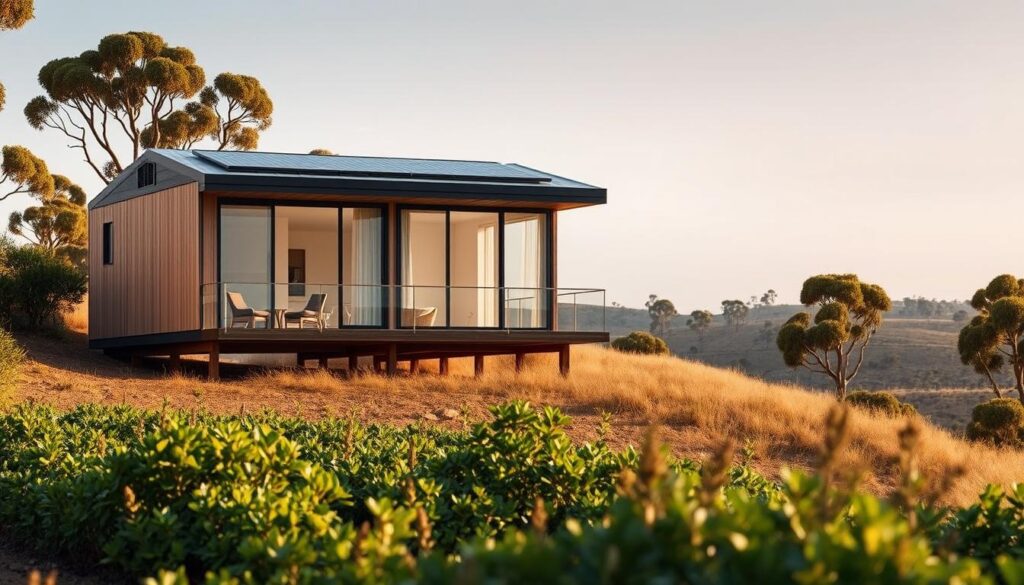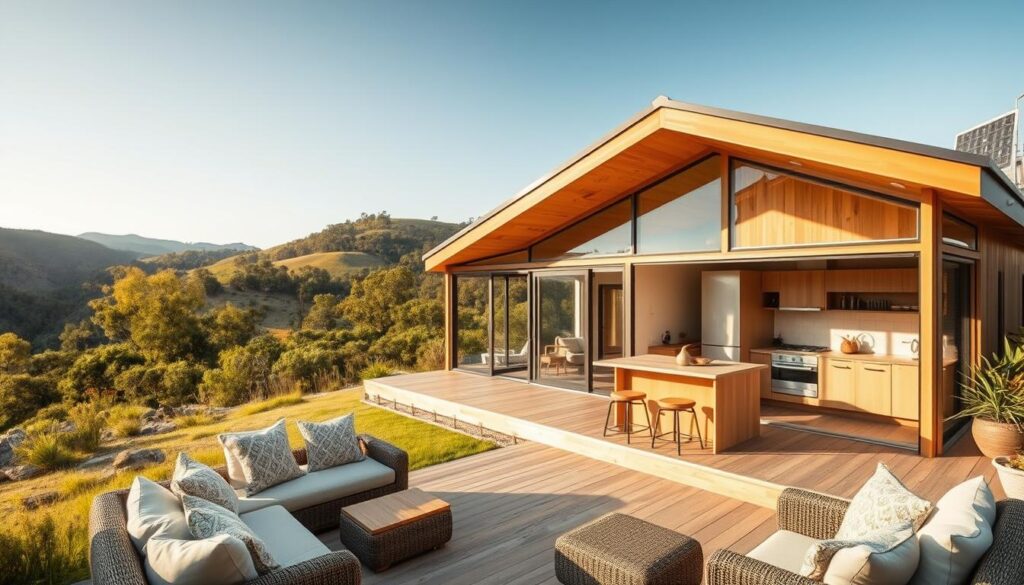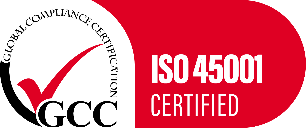As we look for new ways to live sustainably, transportable homes are becoming a popular choice for eco-aware Australians.
In New South Wales, more people want eco-friendly living solutions. Transportable homes are leading this trend.
We're moving towards homes that are good for the planet and flexible. But are these homes really sustainable? Do they mark the future of housing in NSW?
We'll dive into the perks of portable eco homes. We'll compare them to regular homes, looking at their environmental, economic, and practical sides.
The demand for eco-friendly homes is changing how we live in NSW. With growing environmental worries and high housing costs, more people are looking at sustainable options.
NSW faces big housing problems, like high property prices and urban sprawl. In Sydney, the median house price has gone up a lot. This makes owning a home hard for many.
Environmental issues are also a big concern, with climate change affecting the area. These problems are making people and leaders think differently about housing.
Affordability issues are a major problem, with many finding it hard to get a place to live. The issue is made worse by urbanization and the pressure it puts on infrastructure.
Transportable homes are becoming a good answer to these problems. The interest in eco-friendly modular living in Australia, and NSW in particular, is growing. These homes are better for the environment and can be moved, making them flexible.
The move to transportable homes is because they solve economic and environmental problems. They are adaptable and sustainable, showing a big step forward in housing.
Exploring sustainable living in NSW means learning about portable eco homes. These homes are changing how we see housing. They offer a green and flexible choice compared to traditional homes.
Portable eco homes focus on being green and easy to move. They're made in factories to cut down on waste. The materials used are eco-friendly, like recycled steel and sustainable wood.
The building process is modular. This means the home is built in parts in a factory. Then, these parts are moved to the site and put together. This method saves time and reduces harm to the environment.
In NSW, there's a variety of transportable eco homes. They meet different needs and tastes. Here are some examples:
These homes vary in size, mobility, and green features. They give many options for those wanting to live eco-friendly.
Portable eco homes are different from traditional houses in many ways. They're made to be light and easy to move, using modular construction techniques. They also offer the chance to move the home if needed.
These homes are all about being green and reducing harm to the environment. They challenge old ideas about owning and building homes.
Knowing these differences helps us see the special value of portable eco homes in NSW.
Relocatable eco homes are becoming a popular choice for sustainable living. They offer many environmental benefits. This makes them a great option for those who care about the planet in Australia.
One big advantage of relocatable eco homes is less waste and better resource use. The factory setting means materials are ordered and recycled precisely. This cuts down waste a lot compared to building on-site.
Research shows modular homes can cut waste by up to 90%. This is thanks to:
David Johnston, co-author of "Green from the Ground Up," says modular homes reduce waste and save money. This is good for the planet and your wallet.
Relocatable eco homes also have a lower carbon footprint. This includes from making to moving and using them. They use materials efficiently in the factory.
A study by the Modular Building Institute found modular homes use 20% less energy. They also use energy-saving features. This lowers their carbon footprint even more.
As
"The built environment is responsible for a significant portion of global greenhouse gas emissions. Modular homes offer a more sustainable alternative."
This shows why we should think about a building's whole life when looking at its environmental impact.
Relocatable eco homes can also adapt to environmental changes. They can handle challenges like bushfires, floods, and climate shifts.
For example, they can be made with:
This makes them more resilient and sustainable. It also means they don't need to be rebuilt or fixed up a lot after disasters.
Portable eco homes are a cost-effective choice in NSW. They offer financial benefits that traditional housing can't match. These homes are great for saving money upfront and in the long run.
The cost of portable eco homes is often similar to, or even less than, traditional houses. Prices for these homes in NSW range from $80,000 to $200,000. This depends on the size and features.
Traditional homes in NSW start at around $150,000. But, they can go over $300,000 for more complex designs.
| Home Type | Average Cost (NSW) | Size Range |
|---|---|---|
| Portable Eco Home | $80,000 - $200,000 | 1-3 bedrooms |
| Conventional Home | $150,000 - $500,000+ | 1-5 bedrooms |
Portable eco homes save money over time. They are built to be energy efficient. This means lower utility bills.
These homes often have solar panels. This makes them energy independent. Homeowners in NSW can even sell extra energy back to the grid.
Features like rainwater harvesting and greywater systems save water. They also cut down on water bills. This leads to big savings over time.
Portable eco homes are flexible and a good investment. They can be moved to different places. This makes them perfect for investors or those who like to move around.
In tourist areas of NSW, these homes can be rented out. This provides a steady income. Their ability to adapt to market changes makes them even more appealing.
In summary, portable eco homes in NSW are a smart choice. They are affordable, save money in the long run, and are a good investment. These homes are set to be a big part of sustainable living in NSW.
Affordable modular builders in NSW are changing how we see sustainable homes. They offer eco-friendly and cost-effective options for people wanting to live green.
Several companies are at the forefront of sustainable prefab building in NSW. Modular Homes Australia is known for its eco-friendly designs. Prefab Aussie offers customizable homes. Versa Building Systems and Masterton Homes are also making waves with their innovative building methods.
The cost of modular homes in NSW varies a lot. Prices start at $80,000 for a basic studio and can go over $300,000 for a large family home. There are financing options available, including specialized prefab construction loans. Government incentives also help make these homes more affordable.
Most customers are happy with affordable modular builders in NSW. They like the quick construction and the homes' environmental benefits. But, some face issues with council approvals and compliance. Despite this, many are glad they chose a modular home.
Australians are moving towards eco-friendly modular living. Designers are creating homes that are good for the planet and better for living. We'll look at the new designs changing prefab homes in Australia.
The trends in eco-friendly modular living in Australia mix sustainability, function, and beauty. Prefab homes are made to fit Australia's landscape and climate. They use materials and methods that are kinder to the environment.
Designs are becoming more flexible and adaptable. Some homes have parts that can be rearranged to fit different sites or needs.
Australian architects are trying new materials and ways of building. They use cross-laminated timber (CLT) and structural insulated panels (SIPs). These methods make homes sustainable, strong, and healthier for those who live there.
Modular homes are designed to use space wisely. Australian designers use smart strategies like multi-purpose rooms, built-in storage, and transformable furniture. These ideas help make the most of space without feeling cramped.
For example, a living room can also be a home office or guest room. This flexibility meets the changing needs of a household.

Australia's climate is perfect for indoor-outdoor living. Eco-friendly modular homes are designed to make the most of this. They have fold-away walls, big sliding glass doors, and outdoor living areas.
These features improve the living experience and connect us with nature. They make homes feel bigger and more versatile.
In NSW, homeowners can blend sustainability with modern living in prefab homes. These homes aim to cut down on environmental harm while keeping costs low. We'll look at top design tips for saving energy in prefab homes.
Passive solar design is key in energy-saving prefab homes. Homes face north to get more natural heat and cool. Large windows on the northern side soak up heat in winter. Strategically placed shading devices keep it cool in summer.
Thermal mass elements, like concrete, help keep temperatures steady. They absorb and release heat, keeping the home comfortable.
Good insulation keeps homes cozy and cuts energy use. Modern prefab homes use top-notch insulation like high-performance fiberglass or spray foam insulation. This insulation is installed with precision in a factory setting.
This means less air leaks and better energy saving. Adding air sealing techniques boosts the home's energy efficiency even more.
Smart home tech elevates energy efficiency in prefab homes. Automated systems adjust lights, heat, and cool based on who's home and when. Smart thermostats learn your habits and adjust the temperature.
Energy monitoring systems show how much energy you use in real-time. Automated shading systems adjust to let in natural light and keep the heat out. This all adds up to a more energy-efficient home.
By using these design ideas, NSW homeowners can live in homes that are comfy, green, and save on bills.
Understanding NSW's rules is key for those looking at portable eco homes. The journey includes several steps and people, from council approvals to building codes.
Council approval for transportable homes varies in NSW. You need to check if your project needs a full development application or if it's a complying development. Complying development is quicker if your project meets certain criteria.
Choosing the right affordable modular builders NSW can help. They know the local council rules well.
Transportable homes must follow NSW and National Construction Code rules. Focus areas include structure, energy efficiency, bushfire safety, and accessibility. Homeowners and builders often face issues with BASIX, getting occupancy certificates, and council concerns.
To tackle these issues, team up with certifiers who get modular building. Make sure the specs meet NSW's rules.
In NSW, transportable sustainable homes are making a big difference. They're used in cities and countryside, providing homes that are good for the planet and affordable. These homes meet different needs, showing their value.
In cities like Sydney, Newcastle, and Wollongong, these homes are used as extra places to live. They help people find affordable housing and make money by renting them out. For example, a family in Western Sydney added a granny flat for their elderly parents. This improved their living situation and kept everyone independent.

In rural NSW, these homes are a solution when building is hard. The Blue Mountains and Northern Rivers have seen many projects. These homes blend well with nature, making living there eco-friendly.
These homes are also used in big community projects. They're part of eco-villages and affordable housing. For example, a community in the Southern Highlands built an eco-village. It has homes made from transportable units, a shared solar power system, and rainwater collection.
| Region | Type of Development | Key Features |
|---|---|---|
| Western Sydney | Urban Infill | Secondary dwellings for multigenerational living |
| Northern Rivers | Rural Retreats | Eco-friendly homes with minimal environmental impact |
| Southern Highlands | Eco-Village | Community solar power and rainwater harvesting |
These stories show how transportable sustainable homes are changing NSW. They're versatile and have a big positive effect on the environment and communities.
Exploring transportable homes comes with its own set of challenges. These homes offer many benefits, but there are things to think about before deciding. It's important to weigh these factors to see if they fit your needs.
Finding the right land for your portable home can be tough. Zoning laws, covenants, and site prep costs are just a few hurdles. Make sure the land is easy to reach and has the right utilities.
| Land Acquisition Challenges | Site Preparation Requirements |
|---|---|
| Zoning restrictions | Foundation preparation |
| Covenant issues | Utilities connections |
| Land accessibility | Delivery access |
Getting a loan for a portable home can be tricky. Lenders might see these homes differently, affecting your loan and rates. Insurance can also be more expensive due to their unique nature.
The value of your portable home can change over time. Things like design, green features, and location play a big role. There's a chance the value could drop if the market shifts.
Knowing the challenges helps you decide if a transportable home is right for you. With careful planning and research, you can overcome these hurdles and have a successful experience.
The transportable housing industry in Australia is set for big changes. New technologies and what people want are driving this. We'll see more sustainable living options that are also affordable.
New tech is changing the portable housing world. 3D-printed components and advanced sustainable materials are becoming common. They cut down on waste and make homes more energy-efficient.
Robots are also being used in building prefab homes. This makes the process more precise and cheaper. Plus, digital twin technology lets us monitor homes virtually in real-time.
| Technology | Benefits |
|---|---|
| 3D-printed components | Reduced construction waste, improved precision |
| Advanced sustainable materials | Enhanced energy efficiency, eco-friendly |
| Robotics in prefab construction | Increased precision, reduced labor costs |
Australians want homes that are smaller, can go off-grid, and have nature inside. They also want homes that can change with their lives. This is pushing prefab homes to be more adaptable and green.
Australia's harsh weather is influencing portable housing designs. Homes are now built to withstand bushfires, floods, and heat. Companies are adding features to make homes self-sufficient during disasters, making them more resilient.
Transportable homes are a big step towards sustainable living in NSW. They offer many environmental benefits, like less waste and a smaller carbon footprint. These homes are designed to be energy efficient, fitting well with NSW's climate and needs.
These homes also save money upfront and use energy wisely over time. As new ideas in portable housing come up, we'll see even more green designs. But, how fast they become common depends on rules and what people want.
In NSW, transportable homes could be a key solution for housing needs and sustainability. We suggest thinking about your own housing needs and values. See if the perks of transportable homes match your goals.


